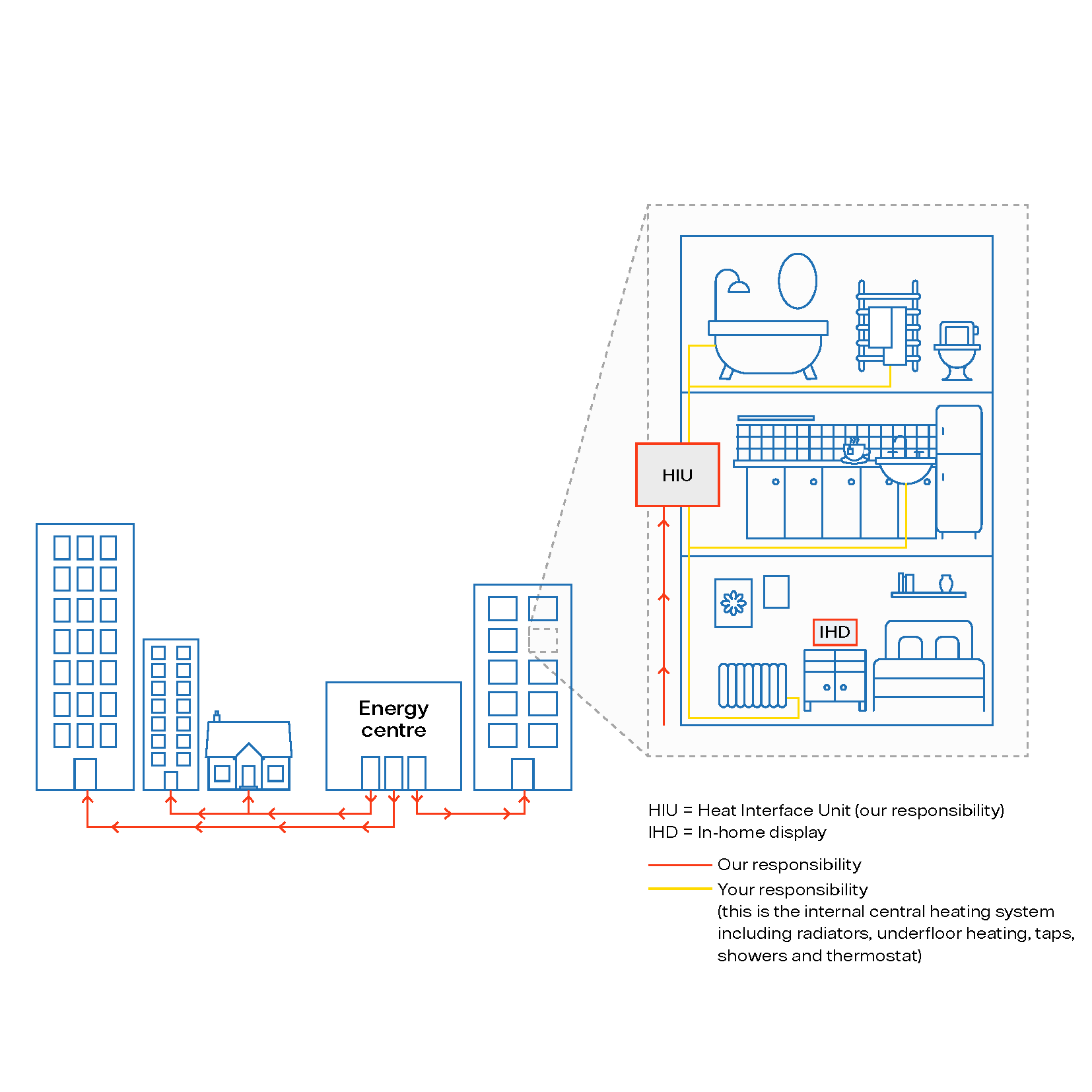

Frequently asked questions
1. About heat networks
What is a heat network?
A heat network is a system of insulated pipes that transports hot water from a central source (or multiple sources) to multiple buildings, where it’s used to provide heating and hot water to residents and business in each building.
Heating networks can range in size from a few hundred metres of pipe, supplying just a few homes, to several kilometres supplying heat and hot water to multiple buildings in a development. They provide a more efficient way of heating our homes and businesses by using a larger central heating source instead of lots of small individual heating systems.
How many heat networks are there in the UK?
The UK government maintains a database of registered heat networks in the UK. In 2015, there were just under 14,000 heat networks serving nearly 480,000 customers. The UK government is investing in heat networks because they provide a reliable and efficient way of heating homes and businesses, and are important in moving to a stronger energy system that used low carbon sources. Up to five million homes could be on a heat network by 2030.
Can I switch energy supplier if I don’t want to be on a heat network?
For a heat network to maximise its potential, it provides heating and hot water (and in some cases cooling) to all the properties in a development. This means that there is one heat network operator fo r the entire development and you can’t switch to a different supplier for heat.
However, your electricity is separate and you can choose your electricity supplier.
We’re committed to providing an excellent service to all our customers and have Guaranteed Standards of Service. If we fail to meet these, we will compensate you.
In addition, we have registered with Heat Trust – an independent customer- protection scheme that ensures the service we deliver are consistent with the rest of the energy market. This includes access to the Energy Ombudsman.
What is a heat interface unit (HIU)?
A heat interface unit (HIU) is a unit that looks like a boiler from the outside, however it does not burn fuel or produce emissions within your home. The HIU transfers heat from the main heat network into the central heating system in your home to provide heating and hot water.
The amount of heat used is measured accurately with a smart meter inside the HIU, and cooler water is recirculated back through the main network to be reheated again at the energy centre. The main heat network and your central heating system are separate.
Will I have to pay if my heat interface unit (HIU) breaks?
No, your heating charges cover all repairs and maintenance. There is no extra cost for repairing of replacing your HIU, provided you have not damaged the equipment.
What is a heat meter?
There is a heat meter inside the HIU. It measures how much heating and hot water you use. Heat is measured in kilowatt hours, shown as kWh on your statement. You can view how many kWh of heating and hot water you’ve used by logging into your customer account online, checking the ‘My Vattenfall UK’ app, or reading your in-home display.
Who’s responsible for my equipment?

We will take care of the heat network from the energy centre up to and including the HIU and heat meter in your property. The central heating system inside your property remains your responsibility to manage (or if you rent, your landlord’s). This includes radiators, underfloor heating, thermostats, heating programmers, showers and taps.
If you have a problem with your heating and hot water and you’re unsure who’s responsible, please call our Customer Care team – they’ll be happy to help.
Is the equipment safe?
We have a team of experienced heating engineers to keep your heating equipment working safely and efficiently. If you do have any problems then a professional is on-hand to help. We carry out regular maintenance checks to make sure that your equipment remains safe, and to prevent issues before they occur.
Will I have a boiler in my home?
No, your home has an HIU (heat interface unit) instead of a boiler. It looks similar to a boiler and you’ll usually find it in a cupboard. As part of our all-inclusive service, we and take care of all servicing and maintenance for the HIU.
Do you provide my electricity too?
No, we only provide your heat and hot water. You have a separate electricity provider.
Who is the regulator?
The UK Government has appointed Ofgem to be the regulator for heat networks in Great Britain. Ofgem is already the regulator of gas and electricity suppliers. New statutory regulation is being implemented by the government and Ofgem, who will become begin formal regulation in 2025.
In the meantime, we register our heat networks with Heat Trust. They are an independent customer protection scheme for heat networks and make sure the service we deliver is in line with the rest of the energy market. Heat Trust requires suppliers like us to provide our customers with access to the Energy Ombudsman, an independent dispute resolution service.
Why are heat networks better?
Heat networks offer a better way to provide heating and hot water to residents and businesses in an area or city.
Fairly priced: When connected to one of our heat networks, you’ll be served with reliable heating and hot water at a fair price.
All-inclusive service: You won’t have to worry about maintenance as we offer an all-inclusive service with expert customer care.
Dedicated monitoring and support: We have a team monitoring the entire network to ensure it’s running at its best.
Better for the environment: Your property will also be connected to a more resilient, low carbon and future proofed energy system that improves air quality both in your home and local community, and helps the UK reach its net zero targets.
2. Moving in and out of your home
What’s a heat supply agreement?
A heat supply agreement is a legal contract between you and us , setting out the terms of our service and how we’ll provide heating and hot water to your property. It states what protections are in place if we fail to meet any of our Guaranteed Standards of Service and outlines the compensation you could receive as a result. The heat supply agreement also sets out any actions needed from you to ensure that we can deliver our service; it also outlines your agreement to pay your heat charges when they’re due.
It’s an important document that you should read carefully.
Setting up your account
You can set up your account online or over the phone.
To set up your account online, complete our move-in form. For step-by-step guidance on setting up your heating and hot water account online with us, watch our how-to video below:
To set up your account over the phone, call our Customer Care team at 0808 143 3633 and they will be able to help you.
To create your account, please have the following information ready to complete the move-in form or to provide to our Customer Care team:
- Basic personal information: This includes your full name, supply address, email, contact number.
- Your supply start date: This will be the date that you completed buying your property or the date stated on your rental (tenancy) agreement. It is the date that you became responsible for heat charges at your property.
- Landlord: If you rent your home, we’ll also need contact details of your landlord who owns the property.
- Payment information: This is needed so we can set up your heat bill payments.
- A meter reading: We’ll confirm your starting meter reading.
When you move out your home
If you’re moving home, please complete our moving out form and send it to us at least 14 days before you go so we can close your account in time. Alternatively, please call our Customer Care team who can complete this for you.
We’ll take a final meter reading on the day you move out and use that to produce your final bill. You’ll need to provide us with a forwarding address, in case we need to contact you after you’ve moved.
Your final bill will be sent within six weeks of your moving date. If there’s any credit on your account when it’s closed, we’ll refund this to you within 10 working days of issuing your final statement.
3. Paying for your heating and hot water
How do I pay?
The way you pay depends on the way the heat meter is set up in your home. Your meter will be set up in one of two default payment settings: credit or pay-as-you go. You can change the payment setting of your meter depending on your preference. If you rent your property, the payment setting may be set by your landlord.
What is credit?
If you have a credit meter, we’ll send you a bill each month by email (unless you’ve requested paper bills), outlining the amount of heat and hot water you used in the past month and the charge for this. You’ll find all your bills stored online in your customer account and in the ‘My Vattenfall UK’ app.
How can I pay with a credit meter?
Here are the payment methods we accept:
By variable direct debit – the easiest way to pay your bill is by variable direct debit. This ensures your bills are paid on time. You can set up variable direct debit online via your customer account, through the ‘My Vattenfall UK’ app, or by calling our Customer Care team.
Online – you can pay online through your customer account and via the ‘My Vattenfall UK’ app using your debit or credit card.
What is pay-as-you-go (PAYG)?
If you’re a pay-as-you-go (PAYG) customer, you pay for your heat and hot water in advance by adding credit to your account. It’s like having a PAYG mobile contract. The meter will deduct payments each day to cover the fixed and usage charges for the heat used.
We’ve designed our PAYG option with your convenience in mind. It makes paying for your heating easy, flexible and transparent. Instead of receiving monthly bills, your in-home display shows your live credit balance, and gives an estimate of how long your credit will last for based on your heating and hot water usage pattern. You can also track your credit balance online and by using the ‘My Vattenfall UK’ app.
Try to always keep your account in credit to avoid any temporary suspension to your heating and hot water supply. We provide £5 emergency credit that you can choose to activate if you run out of credit. This is paid back when you next top up.
How do I top up on PAYG?
If you’re a PAYG customer, these are the payment methods we accept:
Online – you can top up online through your customer account or via the ‘My Vattenfall UK’ app using your debit or credit card.
Over the phone – you can call our Customer Care team on 0808 143 3633 and top up over the phone.
At a PayPoint outlet – you can top up in-person at any PayPoint outlet using your PayPoint payment barcode. This can be found in your app and at the top right corner of your welcome letter. You can find your local PayPoint outlet here.
Watch our how-to video below, where we provide more detail on the different top-up methods available and guide you through each topping up process:
What’s the fixed charge?
This is a fixed amount charged each day which covers:
- The cost to provide and maintain your metering and billing system and customer services.
- The cost to maintain and run our energy centre.
- The costs to operate, maintain and replace the heat network and heating equipment that we own and are responsible for. So, there is no additional charge to you for repairing or replacing your HIU or heat meter.
The fixed charge is a daily charge that is payable even if no heating and hot water has been consumed, for example when you’re away from home.
What’s the usage charge?
This is the cost for each kilowatt hour (kWh) of heating and hot water used in your home. It varies each month depending on how much heating and hot water is used.
The usage charge is measured by the heat meter in your home which sends the information to us so we can ensure you receive accurate bills. If for some reason we don’t receive an automatic meter reading, we may have to use an estimate based on previous bills and / or industry guidelines.
Will I be charged if I am away for a long period of time?
Yes. You’ll still be charged your daily fixed charge and for heating and hot water that your home uses.
To help you minimise the consumption of energy while you’re away, you can turn off your heating via your programmer. However, do remember to keep your thermostat above 7 degrees to protect pipes from freezing.
What do I do if I am struggling to pay my bills?
We understand your circumstances can change, which could impact your ability to pay for your heating and hot water. If you’re experiencing payment difficulties, please contact our Customer Care team.
We’re here to help and will work with you to find an affordable solution.
Please don’t delay – failure to make payments might result in your heat being suspended, which could incur additional costs to reconnect your supply.
Please visit our Help and Support page for more information on independent support organisations who specialise in helping customers with debt.
What data do you collect from my meter and what is it used for?
The heat meter measures the amount of heating and hot water you use. We use this to calculate your heating bills correctly.
It also helps us to predict the overall usage on site and see the trends and peaks, which in turn helps us to manage the heat network in a smarter way.
What is a kilowatt hour?
A kilowatt hour (kWh) is a unit of measurement for how much energy is being used. A kilowatt hour doesn’t mean the number of kilowatts used per hour. It’s a unit of measurement that equals the amount of energy that would be used if a 1,000 watt (or 1 kilowatt) appliance ran for one hour.
So, if you switched on a 100 watt light bulb, it would take 10 hours to use up 1 kWh of energy.
Your bill will include a start date reading and an end date reading, and show you how many kilowatt hours (kWh) of energy you used in your home between these two dates.
How can I compare my bills to other ways of heating?
Your annual heating and hot water costs not only depend on how much heating and hot water your household uses, but also on the size of your home and, importantly, the energy efficiency of your home. Homes that are more energy efficient typically use less energy compared to a home of a similar size that is less energy efficient.
Heating and hot water costs on heat networks are all-inclusive. There are no additional repair or annual servicing charges like you would have on an individual heating system, like a gas boiler.
We understand that you may wish to see how your heating and hot water costs compare with another type of heating, such as a gas boiler. Heat Trust has developed a Heat Cost Calculator that allows you to compare your annual heating and hot water costs to a similar sized property with a gas boiler.
You can access the Heat Cost Calculator here: calculator.heattrust.org.
4. Managing your heating and hot water
At what temperature will the heat be supplied to my home?
We ensure that our heat networks provide sufficient heat to meet the desired temperatures for each home connected to the network. If your water temperature is only lukewarm, please contact our Customer Care team as soon as you can.
Can I control the temperature of the heating in my home?
Yes, you can control the temperature of your heating using the thermostat and programmer of your home’s central heating system. Use the thermostatic radiator valves (TRVs) on your radiators to control the temperature in different rooms. Please note that we’re not responsible for the central heating system (radiators, underfloor heating, TRVs and taps etc.) in your home.
How can I see how much energy I am using?
Your in-home display (IHD) will show your near real-time heat consumption as well as your historical consumption over previous days, weeks and months. You can also check your usage through the ‘My Vattenfall UK’ app and online through your customer account. If you are on a credit meter, your monthly bill will also include your consumption for the previous month.
How do I use my in-home display (IHD)?
Watch our how-to video for a run through of how your IHD works and how it can help you manage your heating and hot water usage and spending:
If you’re a pay-as-you-go customer, watch our extra how-to video below to discover the extra features your IHD has to support pay-as-you-go customers:
5. Queries and questions
Contact us
You can get in touch with us in several ways. For more details please see our Contact us page.
6. Extra support when you need it
Extra Care for Vattenfall Heat customers
To give you the best service we can, we always try to tailor our service to suit individual needs. We also understand that your circumstances can change over time. If you need extra support or have special requirements, you may be eligible for Extra Care.
For more information, please see Extra Care for Vattenfall Heat customers.


